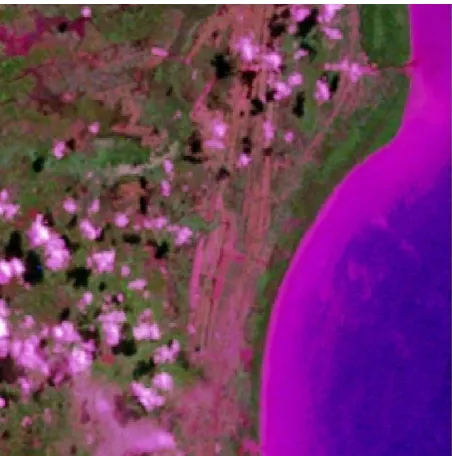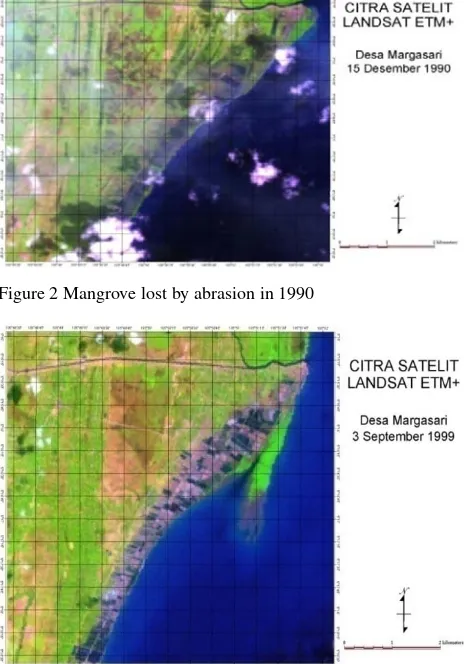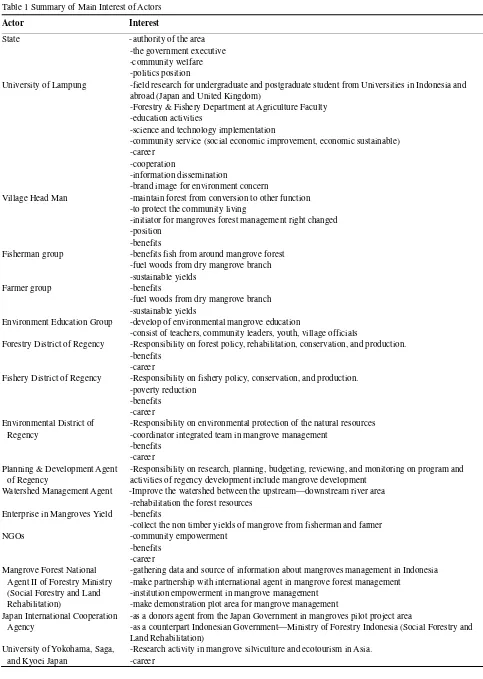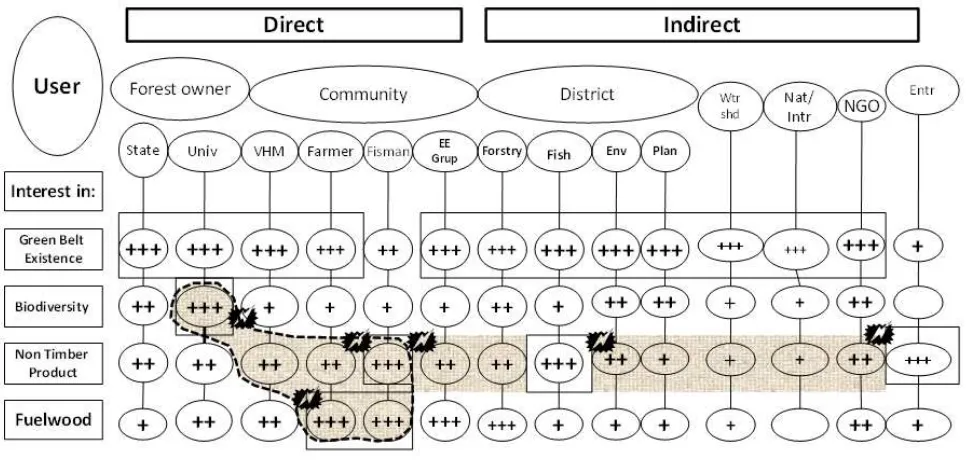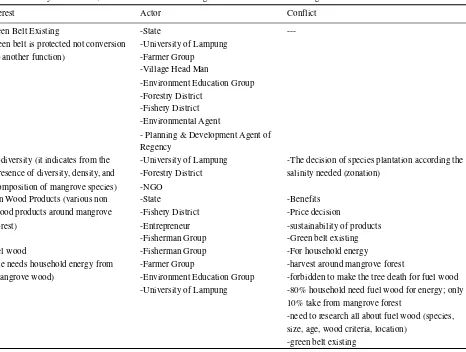Research Report Open Access
Actor, Interest and Conflict in Sustainable Mangrove Forest Management—A
Case from Indonesia
Asihing Kustanti1, , Bramasto Nugroho2, Cecep Kusmana2, Dudung Darusman2, Dodik Nurrochmat2, Max Krott3, Carsten Schusser3,
1. Forestry Department, Faculty of Agriculture, University of Lampung, Indonesia 2. Forest Management Science, Faculty of Forestry, Bogor Agriculture University, Indonesia 3. Forest Politics and Nature Conservation, Faculty of Forestry, University of Goettingen, Germany
Corresponding author email: ingesylva@yahoo.co.id
International Journal of Marine Science, 2014, Vol.4, No.16 doi: 10.5376/ijms.2014.04.0016 Received: 18 Nov., 2013
Accepted: 29 Dec., 2013 Published: 19 Feb., 2014
Copyright © 2014 Kustanti et al., This is an open access article published under the terms of the Creative Commons Attribution License, which permits unrestricted use, distribution, and reproduction in any medium, provided the original work is properly cited.
Preferred citation for this article:
Kustanti et al., 2014, Actor, Interest and Conflict in Sustainable Mangrove Forest Management—A Case from Indonesia, International Journal of Marine Science, Vol.4, No.16: 150-159 (doi: 10.5376/ijms.2014.04.0016)
Abstract Mangrove forests in protected area are common pool resources (CPRs). Characteristics of the forest resource is very dynamic, i.e. exposed to abrasion can be lost and could form arise with widespread forest land toward to the ocean. This phenomenon occurs virtually all coastal in Indonesia. It meets difficulties in determining policy granting ownership rights. The purpose of this study is to identify the role of stakeholders. We used the history description in period of 1977—2004 and analyses on the actors, interests, and conflicts in sustainable mangrove forest management in period of 2005—2010. In this research, we used the case study on the mangrove forest whose characteristic is emerging land, and the people were aware of not cutting forest for the other functions. Lampung Mangrove Center was chosen as a purposive sampling. Involving stakeholders in achieving the common goal of mangrove forest management is accordance with their duties and functions between the three partite cooperation (local government, community, and University of Lampung). The appearance of potential conflict that caused the same powerful interests among stakeholders should discuss to set the rules agreed upon. Interest in education of mangrove forest biodiversity in terms of their effects on the sustainability of non-timber forest products and fuel wood to meet the community household energy needs to enhance by the University of Lampung. The regulation governing the use of only dry branch of mangrove and not mangrove trees cutting is an effort to preserve the mangrove forests.
Keywords Common pool resources; Three partite cooperation; Potential conflict; Forest biodiversity; Non-timber forest product; Household energy
1 Introduction
Mangrove forest along coastal has functioned as a protected area based on Indonesian President Decree Number 32 Year 1990 on management of protection area. The forest has a characteristic of common pool resource, and it tends to damage for the quality and quantity of the forest. The behaviors of the forest users cannot predict in forest utilization. FAO (2003) reported that mangrove forest degradation had reached 5 million hectares in 20 years or 20% of the total width of mangrove in the world. Bengen & Andrianto (1998) also reported that mangrove degradation reached until 47.92% in 11 years. This was caused by the absence of understanding in mangrove characteristics, demand change, mangrove conversion for other uses, nature influence, and social economic condition of the people. The institutions of mangrove forests are required to minimize the free riding, rent
seeking, and opportunistic behavior in order to maximize profits in mangrove utilization.
growth and economic interest (Platteau, 1996; Dachang, 1995) caused rivalry in utilization. State property right changes into private property as an incentive increases in mangrove management.
Schlager and Ostrom (1992) stated that property right change has four property right status e.g.1) withdrawal
right—right to enter, 2) management right—right to
manage, 3) exclusion right—right to exclude non property, and 4) alienation right—right to transfer. Private property right administration for the mangrove forest ecosystem was not successfully managed. Also, it was not ensuring the long endurance of management, sustainability, and incentives of mangrove management (Ostrom, 1990). The private property right can change to common right if there are influences in the change of community, the problem of collective choice, and the policy choice (Kasper and Streit, 1998).
Beside the economic factor as a consideration for mangrove forest management, the characteristic and the sustainability of the resource must also be considered (Scott 2008 and Ostrom 1990) politically, ecologically, and socio economically (Scoones, 1999; Buckles, 1999). In history of the mangrove forest management, it was found that it inhibited management sustainability. Armitage (2002) stated that 1) it was not clear about the right categorization and the forest characterized (Gluck, 2002); 2) actor capacity for environmental change, controlling, and potential conflict; and 3) there was no attention to the community-based forest management.
The involvement of stakeholder in mangrove management is needed because of their characteristics as common pool resources. It can accommodate the
interest and power among the stakeholders for the succes of cooperation (Reed et al, 2004). Further, statement in interest and conflict in forest resources is arised when limited forest resources are used for some interests between stakeholders; therefore, a forest policy should be made as a resolution for the conflict. Policy making is a social bargaining process for regulating conflict of interest (Krott, 2005). As suggested by Wood (1993), there are some changes needed in forest resources management including: 1) building up of awareness of the complexity of natural resources management problems and 2) conflict
resolution approach (Wood, 1993). Regard to mangrove forest as a common pool resource, it needs to know the role of stakeholders in sustainable forest management. Hypothesis in this research is sustainable management of mangrove forests as a goal shared by most across in public.
2 Methodology
To identify the changes of the rights of mangrove forest and the role of stakeholders in its management, we used the history description in period of 1977-2004 and analyses on the actors, interests, and conflicts in sustainable mangrove forest management in period of 2005-2010. In this research, we used the case study on the mangrove forest whose characteristic is emerging land, and the people were aware of not cutting forest for the other functions. The methodology was applied to answer the stakeholders role in the change of the behavior of the communities in their sustainable mangrove forests. Lampung Mangrove Center was chosen as a purposive sampling.
The focus of this paper was on mangrove forest management in period of 2005-2010. This period was a peak of the awareness of the communities to conserve the forest and not cutting it for traditional ponds of prawns anymore. The role of stakeholders increased as the University of Lampung Indonesia became the leader which applied scientific and technological approach.
To analyze the role of stakeholders in mangrove forest management, we used the power, interest, and outcome factors (Schusser, 2012). Types of data were primary and secondary. The primary data were collected through in-depth interviews with questionnaire to 25 respondents, field observations, and surveys. We used purposive sampling to determine respondents (Creswell, 2003) and snowball
sampling (Nuemann) based on the interaction pattern
Japan International Cooperation Agency (JICA), and Yokohama, Saga, and Kyoei University Japan. We also used secondary data containing: a. history data & management program from University of Lampung and East Lampung Regency, b. community, c. governmental (East Lampung Regency) and local institutions (Environmental Education Group), and d. literature study. Data analysis was performed using an Institutional Analysis Design (IAD) by Ostrom (1999)
3 Result
3.1 Mangroves Forest History 3.1.1 Period 1977-1990
The mangrove forest in Margasari Village East Lampung Regency Indonesia is a forest whose function is as a green belt along the coast, and its characteristic is an open access resource (Figure 1).
Figure 1 Mangroves forest as a green belt in 1977
The community with its head of village man was permitted to clear the forest to become 14 traditional prawn ponds. Conversion of mangrove forest to another function occurred starting from 1977, and this was encouraged by the world export booming- especially to Japan, Hongkong, China, America, and some country in Europe (Hidayati et al., 2006). It occurred in Indonesia, Malaysia, Thailand, Vietnam, and Philippines (Alison & Ron, 1998; Barbier, 2006; Adger & Cecilia, 2000; and Hidayati et al., 2006). The price at that time ranged from Rp 120,000/kg; 13 $/kg; or 11 €/kg. The peak of prawn export was in 1980-
1987, but the exertion of prawn ponds from mangrove forest cutting found the trouble.
By the year of 1990, the extensive prawn pond cultivation experienced some problems: 1) prawns had been infected by the virus disease; 2) abrasion from the sea; and 3) decrease of prawns demand. When abrasion happened in 1990-1994, the whole mangrove forest along the coast disappeared, and this alarmed the community that lived along the coast. Also, the 14 ponds prawn disappeared. In addition to that, 12 sub-villages also disappeared. This forest damage had raised the community’s awareness on the important function of mangrove forest in their village. Based on that situation, the forestry district of the province had arranged the rehabilitation program on that forest mangrove area.
3.1.2 Period 1991—1997
In this period abrasion from the sea continued. The mangrove forest disappeared from the land. The community with its neighboring villages was cooperating to rehabilitate the forest by planting the mangrove species, e.g. Avicennia marina and
Rhizophora mucronata. The first rehabilitation was
carried out in 50 hectares in 1995. Then in 1997, mangrove species planted in this area grew successfully there. It was encouraged by the muddy trapping from the sea by the existence of the root of mangrove forest. Therefore the land around the mangrove forest was arisen (Figure 2).
3.1.3 Period 1998-2004
Figure 2 Mangrove lost by abrasion in 1990
Figure 3 Success story of mangroves rehabilitation in 1998
Figure 4 Mangrove growth up until 700 hectares in 2009
By the end of 2004, the former village head man had the idea to give the 50 hectares of forest to University of Lampung as an education forest. He stated that University of Lampung is a credible institution that is able to maintain the forest and not to convert it into another function. University of Lampung had prepared some official processes to get the legitimating from
the government and coordination by the other stakeholder involved.
3.2 Actors, Interest, and Conflict in Period 2005-2010
Since the mangrove forest disappeared on 1991-1995, the community was aware of the mangrove forest function. The village head man had initiative to hand over as wide as 50 hectares from 700 hectares of mangrove forest to the University of Lampung to become an education forest. Officially, the University of Lampung runs the forest through the coordination with the community and local government. Some approaches between the stakeholders have been applied for the mangrove forest management. From these approaches and coordination between the stakeholders, the 700 hectares mangrove forest (wholly wide of forest) has been agreed to be given to University of Lampung. The reason for this is to avoid conflicts in the future if the whole forest area is not run by the university (Figure 4).
As Krott (2005) stated that by using wide-scoped forest expertise, it should be possible to ascertain which sustainable uses of forest are in the interest of common welfare. Also, professional operating need to have broader range of skill and expertise in scientific and technical knowledge available and the communication skills to lead and implement efforts to conserve and sustainable forest management (Thompson, 2000). In mangrove forest management, the University of Lampung applied the tripartite
concept cooperation among the community, University
Tripartite concept means that each stakeholder has organization based on their own duty and functions. The purposes of tripartite cooperation were as follows:
I. Short-term Purpose, 1) the improvement in the capability of human resources of the regency government, University of Lampung, and community; 2) ensure effectiveness and efficiency in managing mangrove forest trough integrated management; 3) increase the revenue of local government and community through community empowerment;
II. Long-term Purpose: 1) to achieve sustainable mangrove forest management through integrated management and community development, 2) to develop a model of mangrove forest management in national scale.
There were several steps of cooperation as follows: 1) ground check survey of the mangrove forest location, 2) equation of the perception among stakeholders in the integrated mangrove forest management. As a result of this, there was an agreement between the University of Lampung and the Local Government for the collaboration activities, and we call it as Memorandum of Understanding (M o U), 3) legitimating of mangrove management to University of Lampung based on the Decision Letter of the Head of Regency Number B. 303/22/SK/2005 on”Location determination of 700 Ha for Mangrove Forest Management in the Framework of Education, Environmental Conservation, and Community Empowerment in Margasari Village of Labuhan
Maringgai District”; 4) arrangement of the integrated
program and activities in mangrove forest management.
Moreover, the stakeholders in integrated mangrove management involved include State Government (Local Government), University of Lampung, Forestry District, Fishery District, Environmental Agent, Planning & Development Agent of Regency, Entrepreneurs, NGO, national and international networking, and community (village head man, farmers, fishermen, and environment education group). The description of main interests of each stakeholder is presented in Table 1.
4 Discussion
There are two important policies that encourage community participation, devolution and decentrali- zation. Devolution is a system in forest management over the aspirations of local communities, local wisdom, and further enhance forest biodiversity. Decentralization is shifting power from central government to the regions in maximizing the development and equalization (Evans et al., 2006). As reported by Agrawal and Gupta (2005); Mark and Sashi (2007); and Papageorgiu et al. (2008) community participation in forest resource management with the CPRs characteristics needed in sustainability efforts. The existence of the community needs to be taken into account because of their activities directly related to the forest (Purnomo et al., 2012). They depend on the existence of forest in associated with the economic, social, and environment safe needs. However, Purnomo et al. (2012) also warned that allowing access community to the forest management must still get assistance and good governance to ensure its sustainability.
Mangrove forest in some developing countries such as Tanzania-East Africa, Philippines, Thailand, and Vietnam has problems in their management. Communities are subsistence who depends on the mangrove forest for their need. Often, utilization of mangrove forests is done by converting it to another function. This causes damage and even loss of mangrove forests. Exacerbated by poor coordination between the local government district agencies (forestry, fisheries, and environment) where they often overlap in the programs and activities of mangrove forest management. It is proposed to cooperate between government district agencies and local communities (Mangora, 2010; Nurse and Kamba, 1999).
Table 1 Summary of Main Interest of Actors
Actor Interest
State -authority of the area
-the government executive -community welfare -politics position
University of Lampung -field research for undergraduate and postgraduate student from Universities in Indonesia and abroad (Japan and United Kingdom)
-Forestry & Fishery Department at Agriculture Faculty -education activities
-science and technology implementation
-community service (social economic improvement, economic sustainable) -career
-cooperation
-information dissemination
-brand image for environment concern
Village Head Man -maintain forest from conversion to other function -to protect the community living
-initiator for mangroves forest management right changed -position
-benefits
Fisherman group -benefits fish from around mangrove forest -fuel woods from dry mangrove branch -sustainable yields
Farmer group -benefits
-fuel woods from dry mangrove branch -sustainable yields
Environment Education Group -develop of environmental mangrove education
-consist of teachers, community leaders, youth, village officials
Forestry District of Regency -Responsibility on forest policy, rehabilitation, conservation, and production. -benefits
-career
Fishery District of Regency -Responsibility on fishery policy, conservation, and production. -poverty reduction
-benefits -career Environmental District of
Regency
-Responsibility on environmental protection of the natural resources -coordinator integrated team in mangrove management
-benefits -career Planning & Development Agent
of Regency
-Responsibility on research, planning, budgeting, reviewing, and monitoring on program and activities of regency development include mangrove development
Watershed Management Agent -Improve the watershed between the upstream—downstream river area -rehabilitation the forest resources
Enterprise in Mangroves Yield -benefits
-collect the non timber yields of mangrove from fisherman and farmer
NGOs -community empowerment
-benefits -career Mangrove Forest National
Agent II of Forestry Ministry (Social Forestry and Land Rehabilitation)
-gathering data and source of information about mangroves management in Indonesia -make partnership with international agent in mangrove forest management
-institution empowerment in mangrove management -make demonstration plot area for mangrove management Japan International Cooperation
Agency
-as a donors agent from the Japan Government in mangroves pilot project area
-as a counterpart Indonesian Government—Ministry of Forestry Indonesia (Social Forestry and Land Rehabilitation)
University of Yokohama, Saga, and Kyoei Japan
the government of East Lampung Regency, and the University of Lampung.
Kustanti et al. (2012) noted that the integrated management in that forest was in an aggressive curve. It indicates that the management should give the priority to the opportunity and minimize the threats from the environmental elements such an abrasion from the sea, facilitation in integrated management, and law enforcement in mangrove forest management. By the year of 2008 the name of Mangrove management changed into Lampung Mangrove Center (LMC) in East Lampung Regency, Indonesia. The mangrove area formed a new land near the sea after the rehabilitation from the Forestry District. The proper of that new land which it disappeared by the abrasion on 1991 cannot claim. It caused according to The Agrarische Wet 1870 this land was state property. Also, according to the Letter of National Land Agency Indonesia Number 410-1293 date 9 May 1996 and the Agrarian Law No 5 Year 1960 stated that the people who lived on land which had been abrated cannot ask for compensation and their right will had been revoked automatically (Kustanti, 2011).
The mangrove forest lies between land and sea; therefore, it needs more complicated approach for running the management. Integrated management should be proposed because it had many stakeholders involve individually and institutionally (Kustanti et al., 2012). The interests of stakeholder can be defined into four aspects: green belt existing, biodiversity, non timber product, and fuel wood (Figure 5).
The description of actors, interests, and conflict of each stakeholder based on theory of Krott (2005) is presented in Table 2 and Figure 5 showed that there are two interests that can be observed from stakeholders. They are the direct and indirect users. Direct users are those that relate directly with mangrove forests such as the State and the University of Lampung. Indirect users are not in direct contact with mangrove forests like the Department of Plantations and Forestry, Department of Marine and Fisheries, The Environment Agency, Planning and Regional Development, Watershed Management Center Way Seputih Way Sekampung, NGOs, National / International Networking, and Entrepreneur. The data showed that among the interests of the actor are green belt, biodiversity, non-wood products, and fuel wood.
Table 2 Summary of the Actor, Interest and Conflict in Mangrove Forest Sustainable Management
Interest Actor Conflict Green Belt Existing
(green belt is protected not conversion to another function)
- Planning & Development Agent of Regency
---
Biodiversity (it indicates from the presence of diversity, density, and composition of mangrove species)
-University of Lampung -Forestry District -NGO
-The decision of species plantation according the salinity needed (zonation)
Non Wood Products (various non wood products around mangrove forest)
(The needs household energy from mangrove wood)
-harvest around mangrove forest
-forbidden to make the tree death for fuel wood -80% household need fuel wood for energy; only 10% take from mangrove forest
-need to research all about fuel wood (species, size, age, wood criteria, location)
-green belt existing
The presence of green belt should be maintained and should not be converted into other uses that would damage the existing mangrove stand. It can be noted that the mangrove stand in the study area was restored after it was vanished in 1990 due to abrasion.
As for the interest of biodiversity, Lampung University is an actor who has strong knowledge and information of the area. Mangrove forests has characteristics compare with the other forest types or other terrestrial habitat in the sense that is highly influenced by the salinity of sea water and has established adaptation from any harsh climatic condition. Meanwhile, according to Schusser (2012) that biodiversity is an important indicator that shows the increasing quality of damaged forests. When biodiversity enhances, it will improve the social and economic values of forest resources.
Non-wood products are the results of improve biodiversity and quality of mangrove forests as these became the stable source fuel wood used by the
farmers and fishermen, improve catch of fish, shellfish, prawn, and crabs. Fuel wood is the fourth interests desired by the user mainly by farmers and fishermen to meet their daily energy. Thus, utilization of dried branches of mangrove tree is recommended for such purpose and cutting of mangrove trees for fuelwood is prohibited. Nurhayati (2008) states that 80% of community needs fuel wood but only 10% of it were taken from the mangroves. Based on interviews with the users, they revealed that they have received information from the University of Lampung that the use of dry branches of mangrove trees is only allowed. This implies that information campaign is one of the tools in educating the locals on the importance of mangroves forest in the area. Agrawal and Gupta (2005) suggested that the local community education is needed to access information about mangroves forest management.
Especially it was in interests of biodiversity (species and composition of mangrove), non-timber products, and the firewood fulfillment for community around mangrove. The potential conflicts were policy making, budgeting, coordination, and implementation in the field. In a period of eight years of management (2004-2012), it observed that more stakeholders want to real benefit from the integrated management. Changes in policy and budgeting, especially at the district forestry of regency sector led to conflict in sustainability mangrove management. Policies and budgeting of programs and activities were influenced by political and policy leadership of the institution involved.
The success of mangrove rehabilitation also raises a potential conflict. It especially was in use of firewood for marginal communities around mangrove forest. It was needed a study to know the mangrove growth, potential, and methods of using eco-friendly for the public welfare.
5 Conclusion
Sustainable management of mangrove forests in Lampung Mangrove Center started from 2004-now by involved the various stakeholders. It was affected by a variety of interests and potential appearance of a conflict. Involving stakeholders in achieving the common goal of mangrove forest management is accordance with their duties and functions. The appearance of a conflict that caused the same powerful interests among stakeholders should discuss to set the rules agreed upon.
Interest in maintaining of green belt was the willingness among the stakeholders. Potential conflicts on biodiversity, non wood products, and fuel woods fulfillment need some regulations, studies, and coordination activities in mangrove integrated management. Education of mangrove forest biodiversity in terms of their effects on the sustainability of non-timber forest products and fuel wood to meet the community household energy needs to enhance by the University of Lampung. The regulation governing the use of only dry branch of mangrove and not mangrove trees cutting is an effort to preserve the mangrove forests.
References
Agrawal A. and Khrisna G., 2005, Decentralization and Participation: The Governance of Common Pool Resources in Nepal’s Terai, World Development, 33: 1101-1114.
http://dx.doi.org/10.1016/j.worlddev.2005.04.009 Alison G., and Ron J., 1998, Analysis Use of Environmental
Function to Communicate The Values of a Mangroves Ecosystem Under Different Management Regimes, Ecological Economics, 25: 232-346.
Armitage D., 2002, Socio-institution Dynamics and The Political Ecology of Mangrove Forest Consevation in Central Sulawesi, Indonesia, Global Environmental Change, 12: 203-217.
http://dx.doi.org/10.1016/S0959-3780(02)00023-7 Barbier EB., 2006, Mangrove Dependency and The Livehoods
of Coastal Communities in Thailand, CAB International. Environmental and Livehoods in Tropical Coastal Zones (eds. C.T. Hoanh, T.P.Tuong, J.W. Gowing and B. Hardy), 126-138.
Besley T., 1995, Property Rights and Investment Incentives: Theory and Evidence from Ghana, Journal of Political Economy, 103 (5): 903-937.
http://dx.doi.org/10.1086/262008
Bromley D.W., 1998, Tenure Regimes and Sustainable Resource Management, Tenure and Sustainable Use, Centre for Development and the Environment, University of Oslo, Norway.
Creswell J.W., 2003, Research Design: Qualitative, Quantitative, and Mixed Methods Approaches, Second Edition, Sage Publications, International Educational and Professional Publisher, Thousand Oaks, London, New Delhi.
Devkota R.R., 2010, Interests and Power as Driver of Community Forestry (A Case Study of Nepal), PhD Thesis, University of Gottingen, Germany.
Evans K., 2006, Guide to Participatory Tools for Forest Community. Bogor, Indonesia: Center for International Forestry Research (CIFOR).
FAO, 2003, Status and trends in mangrove area extent worldwide, By Wilkie, M.L. and Fortuna, S., Forest Resources Assessment Working Paper No. 63. Forest Resources Division, FAO, Rome, (Unpublished).
Gluck P., 2002, Property Rights and Multipurpose Mountain Forest Management, Forest Policy and Economics, 4 (2002): 125-134.
http://dx.doi.org/10.1016/S1389-9341(02)00012-6 Hidayati D., Herry Y., Eniarti D., and dan Toni S., 2006,
Kasper W., and Streit M.E., 1998, Institutional Economics: Social Order and Public Policy. Edward Elgar. Cheltenham, UK. Northampton, MA, USA.
Krott M., 2005, Forest Policy Analysis. Springer, Netherland. Krott M., Bader, A., Devkota, R., Schusser, C., Maryudi, A.,
Aurenhammer, H., In Review, Identifying Driving Forces in Forest Policy Issues by Actor-Centered Power Analysis, International Forestry Review.
Kustanti A., 2011, Mangrove Forest Management, Bogor: IPB Press.
Kustanti A., Nugroho, B., Darusman, D. and Kusmana C., 2012, Integrated Management of Mangrove Ecosystem in Lampung Mangrove Center East Lampung Regency Indonesia, Journal of Coastal Development. 15 (2): 209-216.
Laarman J.G., 1996, Government Policy Affecting Forest in Latin America, Environment Division of Social Program, Inter-American Development Bank, Washington DC. Mangora M.M., 2010, Poverty and Institutional Management
Standoff: A Restoration and Conservation Dilemma for Mangrove Forests of Tanzania, Commonwealth Forestry Association
www.cfc2010.org/papers/.../Mangora-s13.pdf
Mendelsohn R., 1999, Property Right and Tropical Deforestation, Oxford Economic Paper. 46: 750-756. Neuman W.L., 2000, Social Research Methods: Qualitative and
Quantitative Approaches, Fourth Edition, University of Wisconsin at Whitewater, Allyn and Bacon.
Nurse M. and John K., 1999, Defining Institutions for Collaborative Mangrove Management: A Case Study from Tanga Tanzania.
http://data.iucn.org/dbtw-wpd/edocs/2000-019-01.pdf Ostrom E., 1990, Governing the Commons: The Evolution of
Institutions for Collective Action, Political Economy of Institutions and Decisions, Cambridge University Press. http://dx.doi.org/10.1017/CBO9780511807763
Reed M.S., 2009, Who’s in and Why? A Typology of Stakeholder
Analysis Methods for Natural Resource Management, Journal of Environmental Management 90 (2009) 1933–1949.
http://dx.doi.org/10.1016/j.jenvman.2009.01.001
Renn O., 1999. A Model for an Analytic-Deliberative Process in Risk Management, Environmental Science and Technology, Vol. 33, No. 18, pp. 3049-3055.
http://dx.doi.org/10.1021/es981283m
Schlager E, and Ostrom E., 1992, Property-Rights Regimes and Natural Resources: A Conceptual Analysis, Land Economics68(3): 249-262.
http://dx.doi.org/10.2307/3146375
Scoones I., 1999, New Ecology on The Social Sciences What Prospects for Fruitful Engagement, Annual Review of Anthropology. 28: 479-507.
http://dx.doi.org/10.1146/annurev.anthro.28.1.479 Scott A., 2008, The Evolution of Resources Property Rights,
Oxford University Press.
http://dx.doi.org/10.1093/acprof:oso/9780198286035.001. 0001
Schusser C., 2012, Who determines biodiversity? An analysis of actors' power and interests in community forestry in Namibia. Forest Policy and Economics.
Thompson H., 2000, Sustainable Forest Management: The Role of The United State Department of Agriculture (USDA) Forest Service, Northeastern Area and State Forestry Agencies
www.na.fs.fed.us/spfo/pubs/sustain/.../roles.pdf
Wood A.P., 1993, Natural Resource Conflicts in South-West Conflicts in South Ethiopia: State, Communities, and The Role of National Conservation Strategy in The Search for Sustainable Development, Nordic Journal of Africa Studies 2(2): 83-99.
Zhang Y., Uusivori J., and Kuuluvainen J., 2000, Impacts of Economics Reform on Rural Forestry in China, Forest Policy and Economics. 1 (2006): 27-40.
